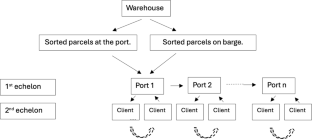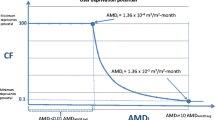Abstract
Many cities have initiated promoting inland waterway transport to serve parcel delivery in urban areas to achieve sustainable transportation. This research aims to identify the key components of an economically viable urban network distribution, where inland waterway transport is deployed as the main transport, and cargo bikes or electric vehicles are used for last-mile delivery. The analysis uses a decision-support framework based on a two-echelon city distribution scheme. Numerical experiments are conducted using near-practical instances in France and inputs from industry stakeholders. From the study, it was found that the economic viability of inland waterways as main transport depends on the number of parcels to be delivered, and the existing infrastructures. The city configurations, their accessibility, as well as their operating conditions are also of utmost importance. The lowest CO2 equivalent emissions are obtained by combining inland waterways with electric bikes. This paper can be used as decision-making support and guidance for transport companies, industry stakeholders, and public authorities for an efficient and sustainable urban distribution network combining inland waterways and bikes/vans.




Similar content being viewed by others
Data availability
The data that support the findings of this study are available on request from the corresponding author, AJ. The data are not publicly available due to confidentiality.
Notes
Delay costs are the costs associated with the value of travel time lost relative to a free-flow situation, while the deadweight loss costs is the part of the delay costs that is regarded as a proper basis for transport pricing.
Roso et al. (2020) show that a barge can replace between 70 and 80 trucks that travel to the same place.
Details on each programme can be found on the European Commission website.
EC and CCNR (2022) provide more details about the projects that have been implemented and those that are still at early stage in Europe.
In practices, the parcels can be sorted either on-board of the barge or at the departure port. In the present framework, we do not make any distinction between these alternatives and consider that the time spent to sort the parcels are the same wherever the sorting location. This allows us to focus on the main operations of IWT and last-mile delivery.
The 100 km may represent the average distance of a typical urban city.
References
ADB, A. A., Furceri, D., & IMF, P. T. (2016). The macroeconomic effects of public investment: Evidence from advanced economies. Journal of Macroeconomics, 50, 224–240.
Al Enezy, O., et al. (2017). Developing a cost calculation model for inland navigation. Research in Transportation Business & Management, 23, 64–74.
Anderluh, A., Nolz, P. C., Hemmelmayr, V. C., & Crainic, T. G. (2021). Multi-objective optimization of a two-echelon vehicle routing problem with vehicle synchronization and ‘grey zone’ customers arising in urban logistics. European Journal of Operational Research, 289(3), 940–958.
Bac, U., & Erdem, M. (2021). Optimization of electric vehicle recharge schedule and routing problem with time windows and partial recharge: A comparative study for an urban logistics fleet. Sustainable Cities and Society, 70, 102883.
Beelen, M. (2011). Structuring and modeling decision-making in the inland navigation sector. Ph.D. Dissertation. Antwerp: Antwerp University.
Calderón-Rivera, N., Bartusevičienė, I., & Ballini, F. (2024a). Sustainable development of inland waterways transport: A review. Journal of Shipping and Trade., 9, 3.
Calderón-Rivera, N., Bartusevičienė, I., & Ballini, F. (2024b). Barriers and solutions for sustainable development of inland waterway transport: A literature review. Transport Economics and Management, 2024(2), 31–44.
Caris, A., Limbourg, S., Macharis, C., Van Lier, T., & Cools, M. (2014). Integration of inland waterway transport in the intermodal supply chain: A taxonomy of research challenges. Journal of Transport Geography, 41, 126–136.
Cempírek, V., Stopka, O., Meško, P., Dočkalíková, I., & Tvrdoň, L. (2021). Design of distribution center location for small e-shop consignments using the Clark-wright method. Transportation Research Procedia, 53, 224–233.
Central Commission for the Navigation of the Rhine (CCNR) (2024). An assessment of new market opportunities for inland waterway transport. Thematic Report. European Commission. February 2024 (p. 157).
Chen, C., Demir, E., Huang, Y., & Qiu, R. (2021). The adoption of self-driving delivery robots in last-mile logistics. Transportation Research Part e: Logistics and Transportation Review, 146, 102214.
Dablanc, L. (2011). City distribution, a key element of the urban economy: Guidelines for practitioners. Edward Elgar Publishing.
EPA (2019). Overview of greenhouse gases. United States Environmental Protection Agency. https://www.epa.gov/ghgemissions/overview-greenhouse-gases
European Commission (2020). Smart and Sustainable Mobility Strategy. Staff Working Document, 2020. Available at: https://ec.europa.eu/info/law/better-regulation/have-your-say/initiatives/12438-Sustainableand-Smart-Mobility-Strategy_en (last consulted on 21.03.2024).
Fontaine, P. (2022). The vehicle routing problem with load-dependent travel times for cargo bicycles. European Journal of Operational Research, 300(3), 1005–1016.
Janjevic, M., & Ndiaye, A. B. (2014). Inland waterways transport for city logistics: A review of experiences and the role of local public authorities. Urban Transport XX, 138, 279–290.
Jonkeren, O., Francke, J., & Visser, J. (2019). A shift-share based tool for assessing the contribution of a modal shift to the decarbonisation of inland freight transport. European Transport Research Review, 11(1), 8.
Jourquin, B., Beuthe, M., & Demilie, C. L. (1999). Freight bundling network models: Methodology and application. Transportation Planning and Technology, 23(2), 157–177.
Lendjel, E., & Fischman, M. (2014). Innovations in barge transport for supplying French urban dense areas: A transaction costs approach. Supply Chain Forum: An International Journal, 15(4), 16–27.
Macharis, C., Caris, A., Jourquin, B., & Pekin, E. (2011). A decision support framework for intermodal transport policy. European Transport Research Review, 3, 167–178.
Malladi, S. S., Christensen, J. M., Ramírez, D., Larsen, A., & Pacino, D. (2022). Stochastic fleet mix optimization: Evaluating electromobility in urban logistics. Transportation Research Part E: Logistics and Transportation Review, 158, 102554.
Marrekchi, E., Besbes, W., Dhouib, D., & Demir, E. (2021). A review of recent advances in the operations research literature on the green routing problem and its variants. Annals of Operations Research, 304, 529–574.
Mühlbauer, F., & Fontaine, P. (2021). A parallelized large neighborhood search heuristic for the asymmetric two-echelon vehicle routing problem with swap containers for cargo bicycles. European Journal of Operational Research, 289(2), 742–757.
Oulfarsi, S. (2016). Inland waterway transport of goods in France: What favorable growth prospects for sustainable development? Transport & Logistics: the International Journal, 16(40), 19–25.
Rai, H. B., Van Lier, T., Meers, D., & Macharis, C. (2017). Improving urban freight transport sustainability: Policy assessment framework and case study. Research in Transportation Economics, 64, 26–35.
Ramirez-Villamil, A., Jaegler, A., & Montoya-Torres, J. R. (2021). Sustainable local pickup and delivery: The case of Paris. Research in Transportation Business Management, 45, 100692.
Ramirez-Villamil, A., Montoya-Torres, J. R., & Jaegler, A. (2023). Urban logistics through river: A two-echelon distribution model. Applied Sciences, 13(12), 7259.
Reyes-Rubiano, L., Ferone, D., Juan, A. A., & Faulin, J. (2019). A simheuristic for routing electric vehicles with limited driving ranges and stochastic travel times. Sort, 1, 3–24.
Rezgui, D., Aggoune-Mtalaa, W., Bouziri, H., & Siala, J. C. (2019). An enhanced evolutionary method for routing a fleet of electric modular vehicles. In 2019 6th International conference on models and technologies for intelligent transportation systems (MT-ITS) (pp. 1–9). https://doi.org/10.1109/MTITS.2019.8883377
Roso, V., Vural, C., Abrahamsson, A., Engström, M., Rogerson, S., & Santén, V. (2020). Drivers and barriers for inland waterway transportation. Operations and Supply Chain Management: An International Journal, 13(4), 406–417.
Strale, M. (2019). Sustainable urban logistics: What are we talking about? Transportation Research Part a: Policy and Practice, 130, 745–751.
Tahami, H., Rabadi, G., & Haouari, M. (2020). Exact approaches for routing capacitated electric vehicles. Transportation Research Part E: Logistics and Transportation Review, 144, 102126.
United Nations (2015). Sustainable development goals. Report. New York, USA.
Van Duin, J. H. R., Tavasszy, L. A., & Quak, H. J. (2013). Towards E (lectric)- urban freight: first promising steps in the electric vehicle revolution. European Transport-Trasporti Europei, 54.
Van Essen, H., Van Wijngaarden, L., Schroten, A., Sutter, D., Bieler, C., Maffii, S., Brambilla, M., Fiorello, D., Fermi, F., Parolin, R., & El Beyrouty, K. (2019). Handbook on the external costs of transport (No. 18.4 K83. 131).
Wang, H., Li, M., Wang, Z., Li, W., Hou, T., Yang, X., Zhao, Z., Wang, Z., & Sun, T. (2022). Heterogeneous fleets for green vehicle routing problem with traffic restrictions. IEEE Transactions on Intelligent Transportation Systems, 24, 8667–8676. https://doi.org/10.1109/TITS.2022.3197424
Winkenbach, M., Kleindorfer, P. R., & Spinler, S. (2016). Enabling urban logistics services atla posted through multi-echelon location routing. Transportation Science, 50(2), 520–540.
Wiśnicki, B. (2016). Determinants of river ports development into logistics trimodal nodes, illustrated by the ports of the Lower Vistula River. Transportation Research Procedia, 16, 576–586.
Yahyaoui, H., Jaegler, A., & Randrianarisoa, L. M. (2023). A cost calculation model for urban delivery of parcels by river. Research in Transportation and Business Management, 51, 101059.
Funding
This work was supported by a post-doctoral scholarship from GeoPoste.
Author information
Authors and Affiliations
Contributions
Conceptualization: AJ, LR, HY; Data curation: HY; Formal analysis: AJ, HY; Funding acquisition: AJ; Investigation: AJ, LR, HY; Methodology: AJ, LR, HY; Project administration: AJ; Resources: AJ, LR, HY; Software: HY; Supervision: AJ, LR; Validation: AJ, LR; Visualization: AJ, LR, HY; Roles/Writing—original draft: AJ, LR, HY; and Writing—review & editing: AJ, LR.
Corresponding author
Ethics declarations
Conflict of interest
The authors declare that they have no known competing financial interests or personal relationships that could have appeared to influence the work reported in this paper.
Additional information
Publisher's Note
Springer Nature remains neutral with regard to jurisdictional claims in published maps and institutional affiliations.
Rights and permissions
Springer Nature or its licensor (e.g. a society or other partner) holds exclusive rights to this article under a publishing agreement with the author(s) or other rightsholder(s); author self-archiving of the accepted manuscript version of this article is solely governed by the terms of such publishing agreement and applicable law.
About this article
Cite this article
Jaegler, A., Randrianarisoa, L.M. & Yahyaoui, H. Policy decision-support for inland waterway transport in sustainable urban areas: an analysis of economic viability. Ann Oper Res (2024). https://doi.org/10.1007/s10479-024-06034-0
Received:
Accepted:
Published:
DOI: https://doi.org/10.1007/s10479-024-06034-0




